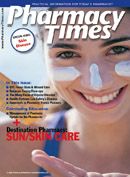Compounding Hotline
COMPOUNDING HOTLINE
Your Compounding Questions Answered
Mr. Erickson is director of professional affairs at Gallipot Inc. Martin A. Erickson III, RPh
Q:
How would I go about compounding glycopyrrolate solution, glycopyrrolate 1% cream, and glycopyrrolate 1% lotion?
A:
Glycopyrrolate oral solution: the drug is shelf­ stable at a pH below 6. Use acidic syrup (pH <6) as a vehicle. Also, glycopyrrolate is available as a shelf­stable aqueous injection. Therefore, an extemporaneously compounded oral solution could be shelf­stable. Based on guidance for nonsterile preparations in USP 32 <795>, Pharmaceutical Compounding, water­containing (“pour­ able”) preparations may be assigned a beyond­use date not later than 14 days from the date of compounding when stored at refrigerated temperatures.
Suggestion:
Glycopyrrolate qs
SyrSpend SF qs ad 100%
1. Weigh/measure ingredients accurately.
2. Using a ceramic or Wedgwood mortar and pestle, reduce the powder to a fine, impalpable consistency.
3. Wet the powder with a small amount of the SyrSpend SF and levigate to a smooth paste.
4. Continue adding aliquots of SyrSpend SF with levigation until a smooth suspension results and about 50% of the SyrSpend SF is incorporated.
5. Transfer this mixture from step 4 to a graduated cylinder.
6. Wash the mortar and pestle with several aliquots of SyrSpend SF and pour into the graduated cylinder to ensure all the active drug is transferred to the cylinder.
7. Add sufficient SyrSpend SF to bring the preparation to the desired volume.
8. Transfer to an amber Rx bottle, label “Shake Well,” “Refrigerate,” etc, as appropriate, and dispense.
Glycopyrrolate 1% Topical Solution
Rx Glycopyrrolate 1 g
Benzyl alcohol 1 g (0.96 mL)
Purified water qs 100 mL
Glycopyrrolate 1% Topical Cream Preparation
Rx Glycopyrrolate 1 g
Oil-in-water cream
(HEB or U-Base), qs ad 100 g
Method of Preparation
1. Weigh/measure ingredients accurately.
2. Using a ceramic or Wedgwood mortar and pestle, reduce the powder to a fine impalpable consistency.
3. Wet the powder with a small amount of propylene glycol and levigate to a smooth paste.
4. Using geometric dilution technique and levigation, incorporate the paste from step 3 into the cream base until smooth.
Refrigerate after compounding. According to USP 32 <795>, a semisolid such as this preparation should be assigned a conservative beyond-use date of 30 days, refrigerated.
For lotion, decrease viscosity of the oil-in-water cream base with water and propylene glycol (more water than propylene glycol).

